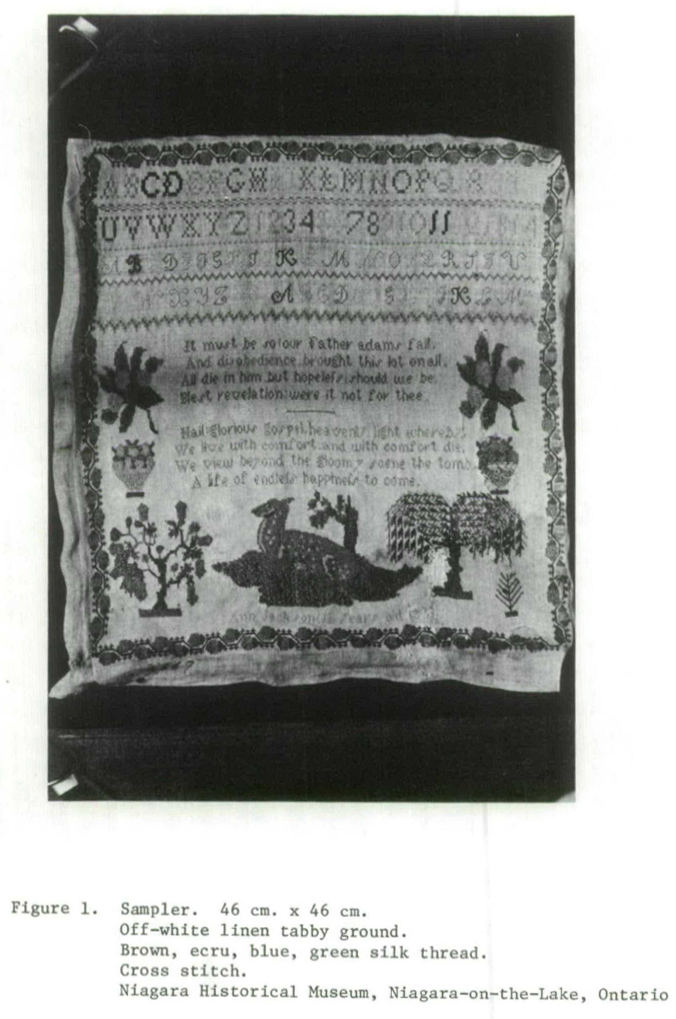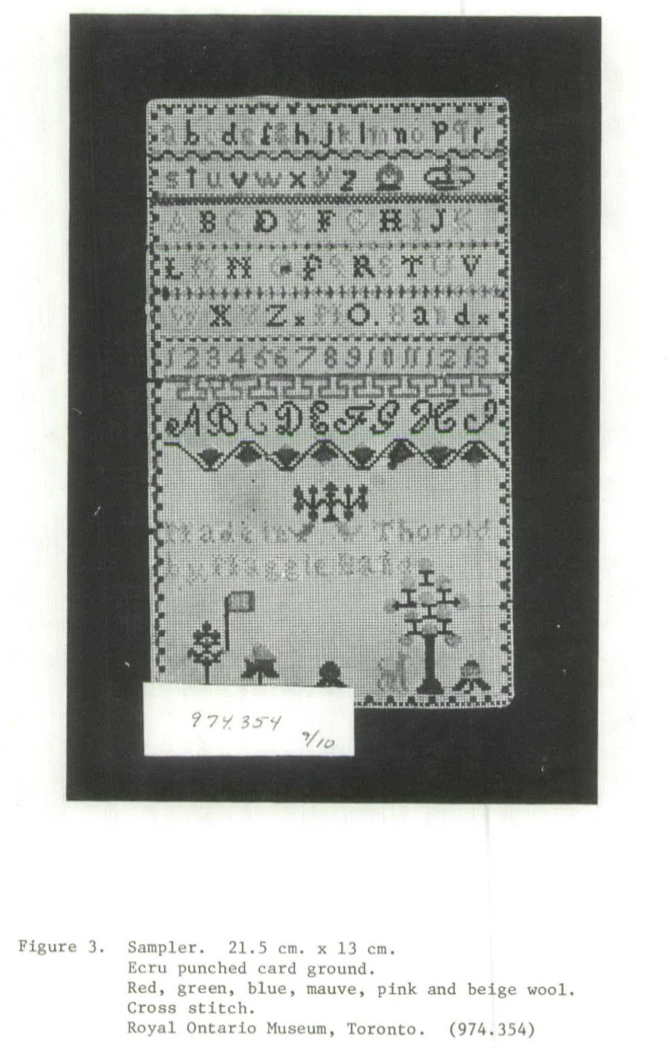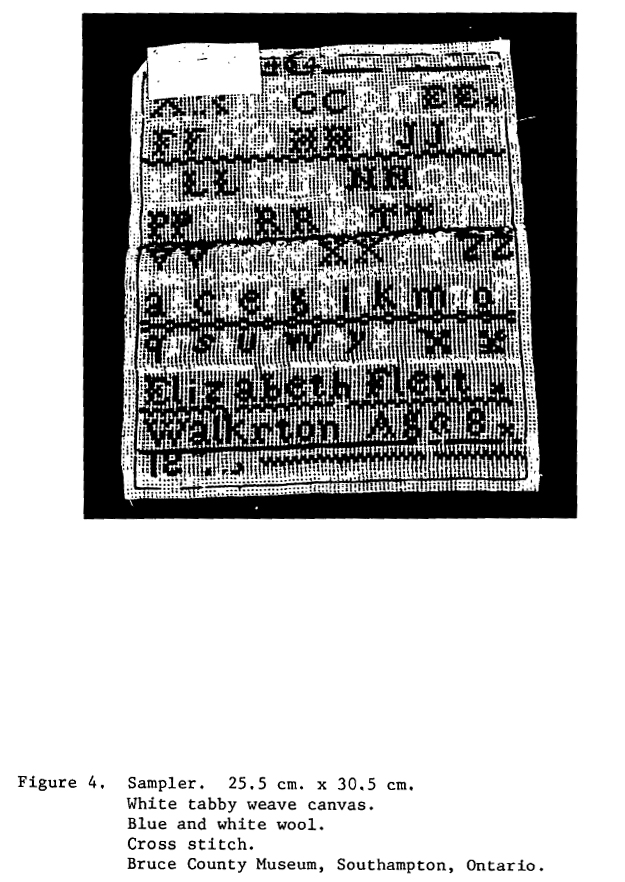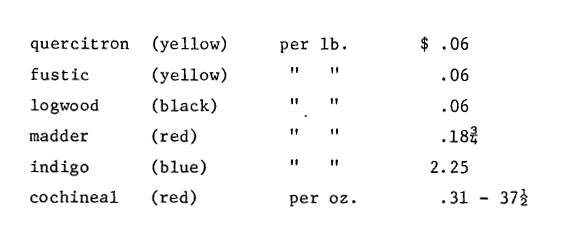Articles
The Dating of Ontario Samplers
1 Among the articles of household, farm and commercial use made in Ontario in the nineteenth century, few are dated. Yet the sampler, that 'example' of a child's skill with the needle and command of letters, was regularly dated. This makes the sampler especially valuable to an historic reconstruction. As the cornerstone of a building authenticates the structure to which it is attached, so also does the dated sampler lend an air of genuine age to the restored room.
2 Yet there are instances when the date is not available. In some cases it has been picked out. In others it has been sewn in with a thread coloured with an iron-based dye and has rotted. Or the date is illegible because the embroideress had sewn it together with her name and age with a thread matching the ground. For these situations it is helpful to have a knowledge of the stylistic progression of the sampler during the nineteenth century.
3 Figure 1 typifies the first type of sampler, dating from the period of initial settlement in the 1790s to approximately 1820. The ground is a tightly woven white linen, with as many as forty-five threads to the warp and weft. The embroidery thread is almost always a finely twisted silk (although sometimes silk floss is also used) in a great number of stitch types. The cross stitch predominated, but it is not unusual to find eyelet stitch, satin stitch, buttonhole, overcast, stem and four-sided stitch.
4 The number of colours in these early pieces is few: black for lettering, green, brown and beige for motifs. This limitation may have been due to the contemporary classicizing taste favouring simplicity and restraint in all matters of architecture and its interior decoration. However, it may have as easily been dictated by the relative cost of dyestuffs. The following price list is from an 1831 publication:1
 Display large image of Figure 1
Display large image of Figure 15 Contrary to the romantic beliefs of many people today, the embroidery threads for a sampler were not dyed by the woman who made the sampler Dyeing silk was a difficult process and only a trained professional dyer would attempt it. Further, the great expense of time and labour rehired to produce a dye from native materials - which were unreliable and impure at best - was hardly justified to produce only a few yards of embroidery thread. Records of sewing silk have turned up in account books of the eighteenth century.2 A dyed silk could just have easily been bought.
6 The motifs in this period are small-scale and delicate. A fine strawberry border may exist. Often there is only one or two sets of alphabets and numbers, inconsequential above the large-scale verse. The motifs below and around the text are often axially arranged. houses and deer are popular, with a sense of three-dimensionality attempted in the placing of the deer on a ground, or in the use of a fenced lawn in front of the house receding into depth. This attempt at pictorial space coupled with the delicacy of technique mark these early samplers as the most ambitious, the most fine.
7 In the 1820s and 1830s the style changes subtlely. A more loosely-woven ground appears, 28 to 30 threads to the inch, still linen but often unbleached. Silk is still the predominant thread, but a tightly-twisted wool appears as well. Fewer types of stitches are used, mostly cross stitch, eyelet, satin, and four-sided. The sampler of this second phase is more colourful as well. Red, green, blue and pink are most noticeable among the new colours.
8 The design is much bolder, as suits the brighter colours. The alphabets and numbers - or the text, as figure 2 - take up more space and the letters are larger. The motifs are fewer, less ambitious, with no sense of three-dimensionality attempted. Rather, the motifs are arranged to cover the ground evenly, not relating to each other logically in terms of space or scale. The entire effect is rich and colourful.
 Display large image of Figure 2
Display large image of Figure 29 In the 1840s thick Berlin wool on an even coarser ground becomes the style. Now there are so many colours that often each letter and number is different from its neighbours. The notion that the introduction of aniline dyes in the 1850s and 1860s made possible the use of bright colours is refuted by these colourful pieces of a decade earlier. The soft Berlin wools took a dye much more easily than the harder silks and twisted wools of previous years and so when brilliance was the desired effect it was natural to turn to Berlin wools. As for the relative cost of dyes, a more settled country with a stronger financial basis could afford the more expensive dyestuffs and the products made with these dyes. Scarlet, however, was always a luxury item.
10 Eyelet, satin and the four-sided stitch appear more rarely in this period; the cross stitch is allowed to thoroughly geometricize the few actifs that remain. Birds and flowers are virtually all that is left of what was once a large repertoire of figures. Likely they continue to be made because they survive best the building block effect of the cross stitch. In this period, as exemplified by figure 3, the motto disappears, crowded out by the large alphabets.
11 The design of the fourth and last type of sampler, made approximately from the 1860s to the end of the century, is simple to the point of being perfunctory. The typical piece, figure 4, is on a ground so coarse it is like a woven string. At times the embroideress has foregone a cloth ground entirely in favour of a punched card (as in figure 3). The cross stitch is the only stitch used; the thread is the thickest of wools; there is often only one, perhaps two, colours. The strawberry border of earlier times has been replaced by a zig-zag or simple straight line. There is often only one alphabet and one set of numbers, with the name and age the only variable features. This is the last stage of the craft's decline.
12 There are, of course, exceptions to the chronological progression outlined above. Stylistically, a very simple piece may be found executed in fine linen, which would date it to a period when samplers tended to be complex. As well, the dividing line between periods is faint. In a medium that is a craft rather than a fine art, tradition makes the rules, not fashion. Nevertheless, some aspect of the material or design will place the sampler in its appropriate time period.
 Display large image of Figure 3
Display large image of Figure 3 Display large image of Figure 4
Display large image of Figure 413 Dated samplers have always been preferred in period reconstructions the date giving the official stamp of age to the arrangement. But to use them exclusively is misrepresentative, since undated ones were also made in very large numbers. It is vital that the undated sampler chosen be of the appropriate period, as the restored room is only as old as the most recent item in it.
